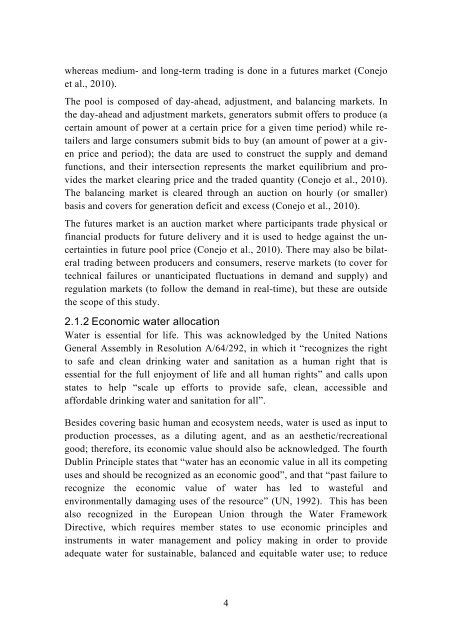A framework for joint management of regional water-energy ... - Orbit
A framework for joint management of regional water-energy ... - Orbit
A framework for joint management of regional water-energy ... - Orbit
You also want an ePaper? Increase the reach of your titles
YUMPU automatically turns print PDFs into web optimized ePapers that Google loves.
whereas medium- and long-term trading is done in a futures market (Conejo<br />
et al., 2010).<br />
The pool is composed <strong>of</strong> day-ahead, adjustment, and balancing markets. In<br />
the day-ahead and adjustment markets, generators submit <strong>of</strong>fers to produce (a<br />
certain amount <strong>of</strong> power at a certain price <strong>for</strong> a given time period) while retailers<br />
and large consumers submit bids to buy (an amount <strong>of</strong> power at a given<br />
price and period); the data are used to construct the supply and demand<br />
functions, and their intersection represents the market equilibrium and provides<br />
the market clearing price and the traded quantity (Conejo et al., 2010).<br />
The balancing market is cleared through an auction on hourly (or smaller)<br />
basis and covers <strong>for</strong> generation deficit and excess (Conejo et al., 2010).<br />
The futures market is an auction market where participants trade physical or<br />
financial products <strong>for</strong> future delivery and it is used to hedge against the uncertainties<br />
in future pool price (Conejo et al., 2010). There may also be bilateral<br />
trading between producers and consumers, reserve markets (to cover <strong>for</strong><br />
technical failures or unanticipated fluctuations in demand and supply) and<br />
regulation markets (to follow the demand in real-time), but these are outside<br />
the scope <strong>of</strong> this study.<br />
2.1.2 Economic <strong>water</strong> allocation<br />
Water is essential <strong>for</strong> life. This was acknowledged by the United Nations<br />
General Assembly in Resolution A/64/292, in which it “recognizes the right<br />
to safe and clean drinking <strong>water</strong> and sanitation as a human right that is<br />
essential <strong>for</strong> the full enjoyment <strong>of</strong> life and all human rights” and calls upon<br />
states to help “scale up ef<strong>for</strong>ts to provide safe, clean, accessible and<br />
af<strong>for</strong>dable drinking <strong>water</strong> and sanitation <strong>for</strong> all”.<br />
Besides covering basic human and ecosystem needs, <strong>water</strong> is used as input to<br />
production processes, as a diluting agent, and as an aesthetic/recreational<br />
good; there<strong>for</strong>e, its economic value should also be acknowledged. The fourth<br />
Dublin Principle states that “<strong>water</strong> has an economic value in all its competing<br />
uses and should be recognized as an economic good”, and that “past failure to<br />
recognize the economic value <strong>of</strong> <strong>water</strong> has led to wasteful and<br />
environmentally damaging uses <strong>of</strong> the resource” (UN, 1992). This has been<br />
also recognized in the European Union through the Water Framework<br />
Directive, which requires member states to use economic principles and<br />
instruments in <strong>water</strong> <strong>management</strong> and policy making in order to provide<br />
adequate <strong>water</strong> <strong>for</strong> sustainable, balanced and equitable <strong>water</strong> use; to reduce<br />
4
















